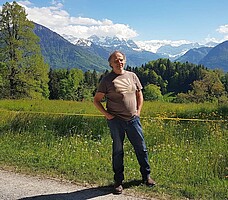Prof. Dr. Andreas Kuhn

About my research in Hohenheim:
In my Hohenheim working group, we were interested in how proteins incorporate themselves into the cell membrane. It was previously assumed that hydrophobic proteins fold themselves (spontaneously) into the membrane after synthesis. However, we were able to show that this is only possible for small proteins. Larger proteins require so-called insertases for a correct topology and their incorporation into the lipid layer.
In collaboration with other research groups, we were able to detect the first insertase (YidC) in the bacterium Escherichia coli, an essential and highly conserved protein. We reconstituted the overexpressed and purified protein in artificial liposomes and demonstrated its enzymatic activity with an added purified and unfolded membrane protein. This was incorporated transmembrane only into liposomes containing the insertase. A substrate protein, which we had modified with a fluorescent dye, could also be incorporated. This made it possible to follow and analyze the kinetics of the incorporation process in vitro using single-molecule spectroscopy.
This technology then made it possible to identify specific inhibitors for the bacterial insertase. As the insertase is essential for the bacterium, the addition of the inhibitor to an E. coli culture was bactericidal. This now opens the door to research into novel antibiotics.
A second focus of our research involves investigating the infection mechanism and the assembly of phages, the bacterial viruses. Phages have to transport their DNA across the cell membrane in order to infect the bacterium. In the case of the T7 phage, this is achieved by the incorporation of a so-called ejectosome, a protein complex that is assembled shortly after the phage is adsorbed in the periplasm. The proteins are located in the phage head and are introduced into the periplasm before the phage DNA. Since the proteins can only pass through the narrow phage neck when unfolded, they have to refold and assemble in the periplasm to form a DNA transporter. It is still not really known how the molecular mechanism for the passage of DNA through the membrane actually takes place.
Awards:
Leibnitz Prize 1998
Badge of Honor of the University 2022
Senior professorship 2019 - 2022
